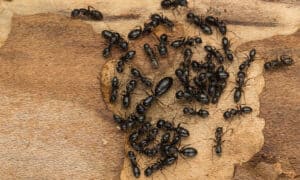Ants are fascinating creatures, but when they invade homes, it’s a nuisance, not least because some species have nasty bites and stings. There are over 792 ant species in North America, but let’s narrow that down and discover the seven types of ants set to emerge in Washington State this summer.

When Do Ants Emerge in Washington State?
Ants like warm weather, and most species emerge in spring when the temperature rises.
Most people notice ants when they swarm. This is called the “nuptial flight” because winged ants mate at this point and fly away from the nest to establish new colonies. Ants chiefly swarm in mid-summer.
Overwintering ant species tend to fall dormant from October onwards, but there are some exceptions, such as the Pharaoh ant that nests in structures and forages all year round.
Let’s discover the seven types of ants set to emerge in Washington State this summer.

Washington State is home to over 792 ant species; most emerge in early spring.
©Danita Delimont/Shutterstock.com
1. Moisture Ants (Lasius sp.)
Lasius species ants, known as moisture ants, reach around 2-3 mm in length and appear yellow to dark brown. They love decaying or wet wood and often make nests in crawlspaces, woodlands, sheds, and attics. They depend on moisture for survival hence the common name “moisture ant.”
In Washington State, moisture ants forage at night, eating honeydew from aphids and hunting small insects. They bite humans, but the bite is painless. In general, moisture ants are a nuisance rather than a danger.
Emerge: Moisture ants set to emerge in Washington state this summer begin to appear in April. Swarming winged ants mate in the air during late September and October and then seal themselves in damp nests for the winter months.
Go Away: By October, moisture ants reach their dormant state and stay that way for winter.
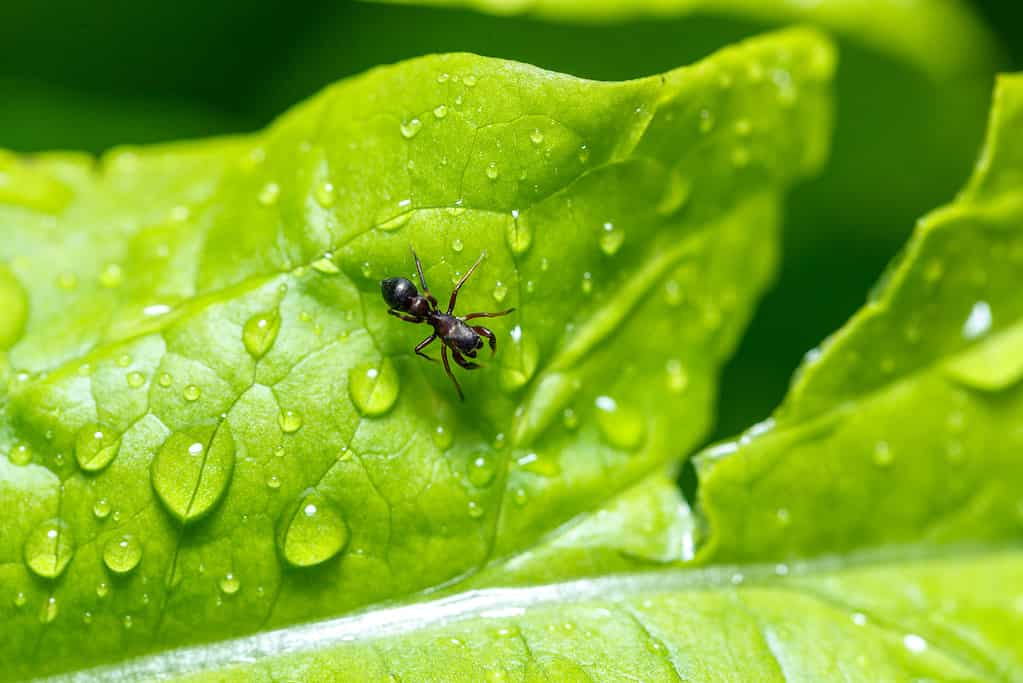
Moisture ants rely on moisture for survival.
©iStock.com/helen89
2. Odorous House Ants (Apinoma sessile)
U.S. native odorous house ants get their name from the rotten, sickly coconut scent they emit when crushed. Dark brown to black in color, odorous house ants reach 3.3 mm long. They nest in urban areas beneath wood, patio stones, and rocks and appear in houses to forage for food.
Nesting ants wake from dormancy when temperatures begin to rise. This means odorous house ants begin to emerge in April. They swarm from May to mid-July, and their reproductive cycle reaches its peak in August. Because they frequently establish new nests, odorous house ants are seen more often than other ant species in Washington State.
Emerge: Odorous house ants emerge in April and fly in mating swarms from May to mid-July.
Go Away: By October, odorous house ants settle down for winter dormancy.

Odorous house ants emit a rotting coconut scent when crushed.
©Dhe Tong/Shutterstock.com
3. Western Thatching Ants (Formica obscuripes)
Western thatching ants are set to emerge in Washington state this summer as temperatures rise. This usually means late April to early May, but winged mating ant swarms appear in late July and August.
These U.S. native red and black ants give a nasty bite that contains formic acid and causes blisters (to you and your pets), so it’s best to steer clear of their leaf, grass, and small stick-constructed nests (hence their name, thatching ants). Thatchers create large mounds that house up to 40,000 individuals. Above ground, their nests reach about 18 inches tall, but beneath; they can reach depths of 3-4 feet.
Emerge: Western thatching ants emerge in mid-March and early April, then swarm in June and July.
Go Away: When temperatures drop, these ants go dormant. This is chiefly October, but mild weather means thatcher ants can persist until late October or even November.
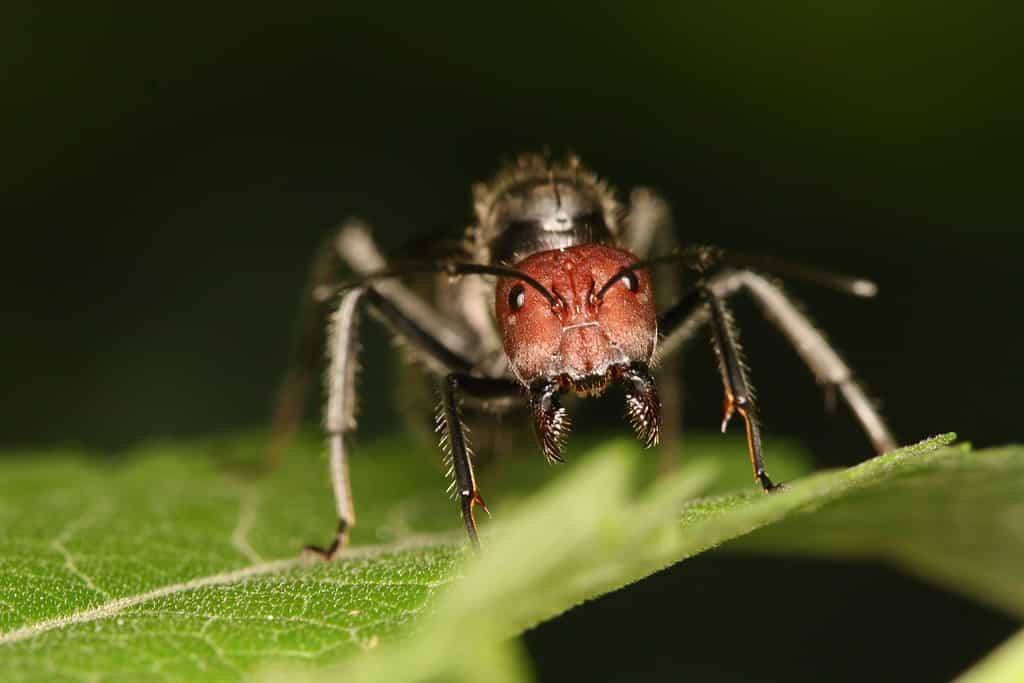
Thatching ants are also known as field ants.
©Rezha Pratama Putra/Shutterstock.com
4. European Fire Ants (Myrmica rubra)
Europe and Asia native European fire ants are invasive ants named after the burning sensation caused by their sting. Small white welts turn to painful throbbing pustules. European fire ants reach 4-5 mm long with two segment waists and a shiny reddish-brown abdomen, so they’re easy to identify.
They begin to emerge to forage for aphid honeydew and small insects in late March, but no swarms have been reported in the U.S. yet. In Europe, mating swarms occur in June and July. So far, hidden European fire ants spread colonies via infected material such as plants and mulch.
Emerge: European fire ants emerge in late March when temperatures rise.
Go Away: By October, European fire ants go dormant. They may seek out dormancy earlier if fall is wet.
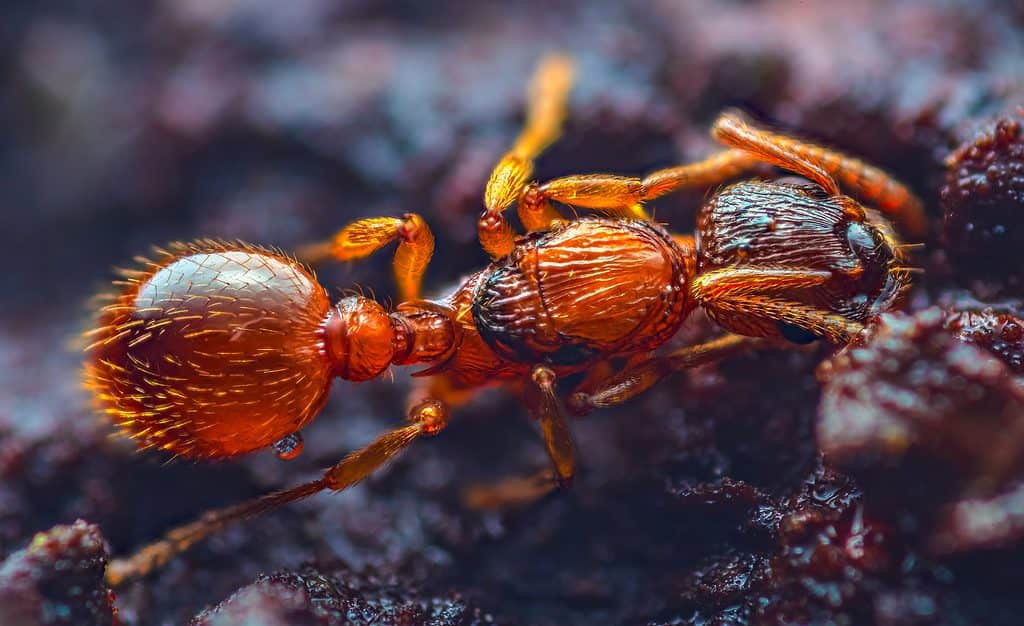
European fire ants’ bite and sting leave white welts and skin blisters.
©Lukas Jonaitis/Shutterstock.com
5. Carpenter Ants (Camponotus sp.)
U.S. native carpenter ants are set to emerge in Washington State this summer. Their large red and black half-inch-long bodies topped off with big heads mean they’re easy to identify. Carpenter ants prefer to nest in damp, moist wood, establishing a colony and creating satellite nests once it’s reached capacity.
They commonly invade homes but support ecosystems in woods and forests by aiding decomposition.
Winged carpenter ants swarm and mate in late June and July, but they begin to emerge for food in late March to early April. Their dormant period is chiefly from October onwards, depending on the temperature. Cold fall will send these industrial workers into earlier dormancy.
Emerge: Early spring from mid-March, then swarm in June to July.
Go Away: Carpenter ants usually bed down for winter by late September and early October.
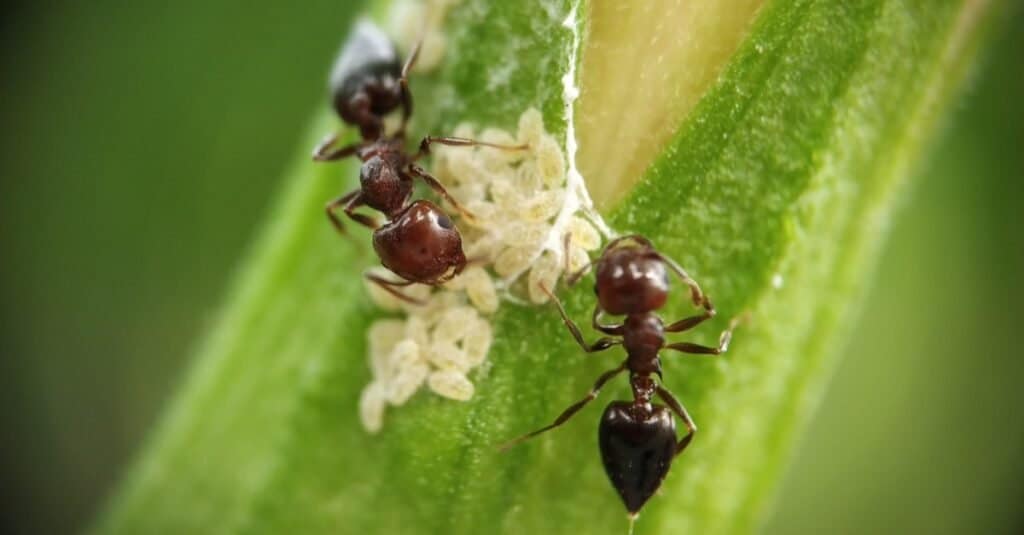
Carpenter ants are the largest U.S. native at half an inch long.
©IamBijayaKumar/Shutterstock.com
6. Pavement Ants (Tetramorium immigrans)
True to their name, pavement ants live in cracks and dry soil along sidewalks, driveways, and footpaths. Although the top nest sections look like mini craters, they extend a meter into the soil below. Pavement ants are European natives introduced to the U.S. via shipping containers. They’re one of the most frequently seen ants in urban areas of Washington state during the summer.
These brown to black-colored ants have pale legs, mild stings, and prefer dry nesting sites. They don’t often invade homes but may enter in late spring to forage for food. These little ants emerge for food when the pavement begins to heat up. They eat almost anything, including insects, breadcrumbs, and codling moth larvae.
Emerge: Because pavement ants tend to heat up quickly in the sun, pavement ants emerge early in February and remain active until their heated structures cool down. In mild climates, they can remain active all year round. Mating swarms occur in June and July.
Go Away: Pavement ants go away in the cold months, usually from late October, but unseasonably warm falls can see them active until December.

Pavement ants typically emerge in the spring and are most active between March and May.
©Ezume Images/Shutterstock.com
7. Pharaoh Ants (Monomorium pharaonic)
Pharaoh ants are originally from North Africa. These light yellow and brown ants are not common, but they prefer warmth, so they infest homes in search of cozy nest sites. They’re known as the most difficult household ant to control.
Because they live indoors, outside temperatures don’t affect them as much as other ant species, so they are generally active all year round. They don’t swarm but mate and raise young in the nest.
Emerge: Present indoors all year.
Go Away: Pharaoh ants don’t go dormant indoors.
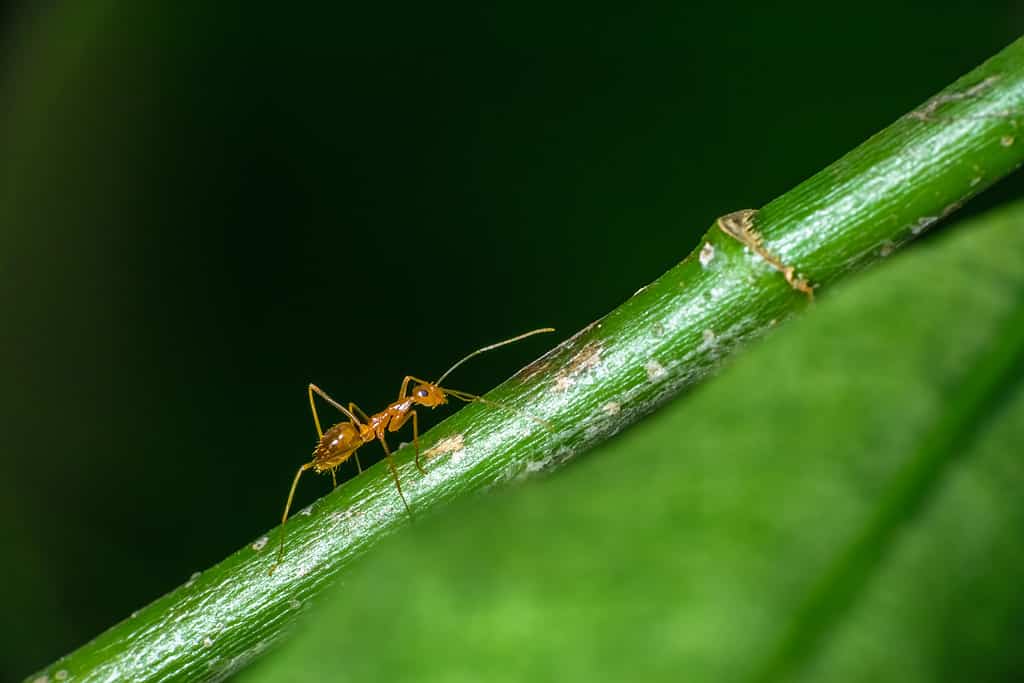
Pharaoh ants originate from North Africa. They’re an invasive pest in Washington State.
©iStock.com/Suman Ghosh
Other Insects Set to Emerge in Washington State This Summer
Ants tend to emerge in Washington state during the early spring months when the temperature begins to rise. Higher temperatures kick-start the insect season! Here are other insects set to emerge in Washington state this summer. Some you’ll welcome, others you’ll need to work with!
American Dog Ticks
American dog ticks live in eastern Washington’s grassland, shrubland, fields, and hiking trails. Although they prefer to feed from wildlife and our pet cats and dogs, they bite and suck human blood too. These vampires carry Rocky Mountain spotted fever but not Lyme disease.
Like Rocky Mountain wood ticks, they have brown bodies that grow from a few millimeters to half an inch once fully gorged.
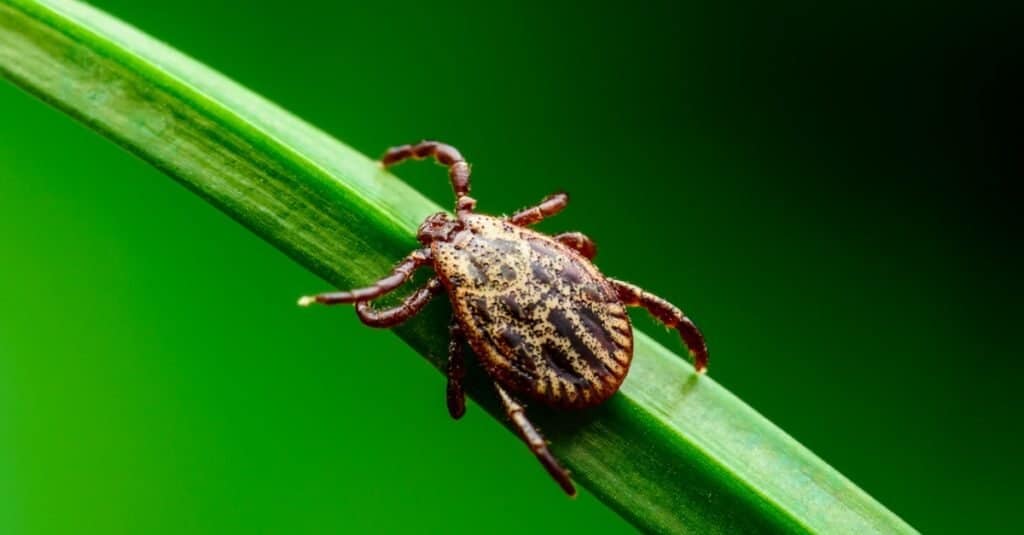
American dog ticks emerge in late spring. They spread Rocky Mountain spotted fever.
©iStock.com/nechaev-kon
Bees
Washington State’s bees forage for nectar in the early spring and summer months when flowers bloom. The most common Washington state species include bumblebees and honeybees.
Although they can sting humans, it’s rare unless their colony is threatened. In general, bees go about their pollen foraging and plant pollination without bothering us. Experts say a third of our food supply is dependent on insect pollination. You can help them by planting more flowers.
Wasps
Paper wasps, hornets, and yellowjackets emerge in Washington state during summer, and they’re never as welcome as bumblebees due to their painful sting and aggressive ‘give me that food’ tactics.
Wasps feed on insects such as flies, crickets, and caterpillars, but when food sources run short, they aren’t opposed to sweet human foods like ketchup and ice cream.
Wasp queens emerge from hibernation in March and April, searching for suitable nesting sites to raise a colony. Many wasps don’t survive winter, but a lucky few find a dry place to hibernate in attics, old tree trunks, or building eaves.
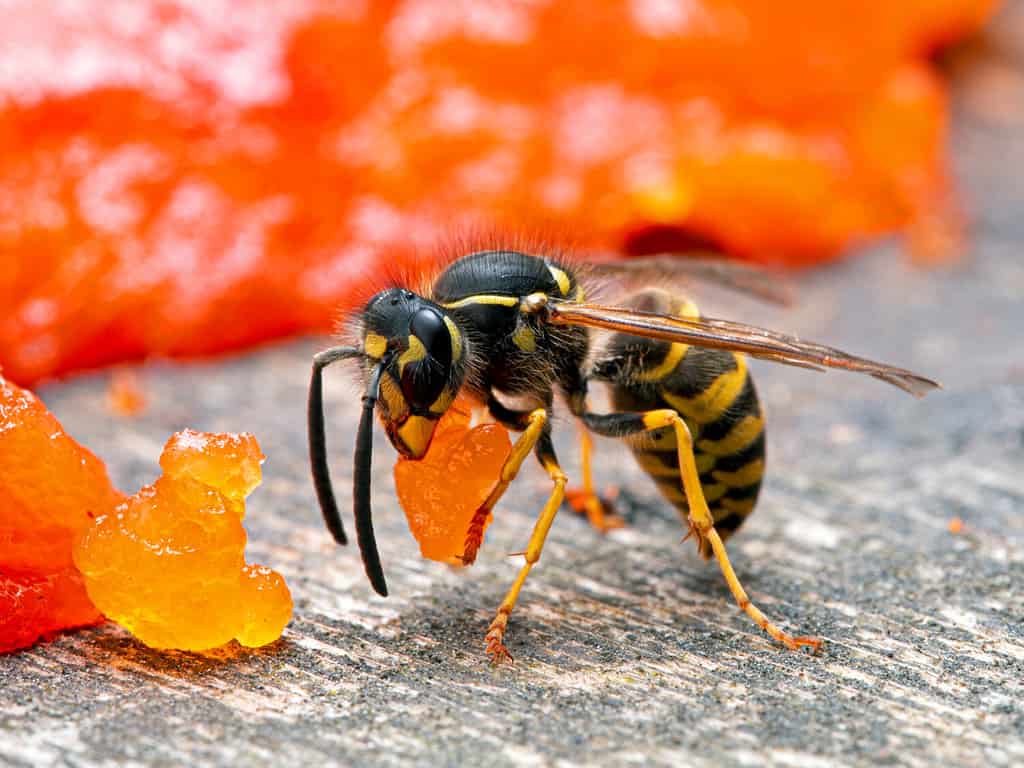
Yellowjacket wasps eat aphids, flies, crickets, caterpillars, and human garbage.
©Ernie Cooper/Shutterstock.com
Snakefly
Snakeflies sound dangerous, but they are simply small insects with long snake-like necks and a long egg-laying tail called an ovipositor. They emerge in Washington in April to forage for small arthropods and aphids.
Harmless snakeflies can’t sting or bite humans. They’re amusing little insects because they can run forward and backward without turning around.
Dragonfly and Damselfly
Washington state is home to at least 24 dragonfly and damselfly species. They’re beautiful adults in red, blue, black, yellow, or green shades and always a welcome visitor. One of the most beautiful is the Common Green Darner (Anax junius) in jeweled shades of iridescent blue and green.
Washington state’s dragonfly and damselfly population chiefly stays near water. Juvenile dragonfly larvae are entirely aquatic. They spend years in ponds and slow-moving rivers, preying on tadpoles and other aquatic invertebrates until they’re able to climb a stem and transform into a flying adult.
Can you tell the difference between a dragonfly and a damselfly? Here are four simple ways to differentiate them:
- Dragonflies have bulky bodies, and damselflies look like twigs
- Damselflies fold their wings at rest, whereas dragonflies tend to spread out
- Dragonfly eyes touch in the center, but damselfly eyes have a gap
- Damselfly wings are skinny, dragonfly hindwings look larger than their forewings
Ants Set to Emerge in Washington State This Summer
Ants set to emerge in Washington state this summer will chiefly appear when the temperature begins to rise in late March and April, but exceptions include pavement ants and pharaoh ants, which can be present all year round!
Whatever season it is in Washington State, you can be sure an ant is foraging nearby.
Summary of the 7 Types of Ants Set to Emerge in Washington State This Summer
| Ant | Active Period | |
|---|---|---|
| 1 | Moisture Ants | April through October |
| 2 | Odorous House Ants | April through October |
| 3 | Western Thatching Ants | Mid-March through November |
| 4 | European Fire Ants | Late March through October |
| 5 | Carpenter Ants | Mid-March through early October |
| 6 | Pavement Ants | February through December |
| 7 | Pharaoh Ants | Active year-round |
The photo featured at the top of this post is © ArtLovePhoto/Shutterstock.com
Thank you for reading! Have some feedback for us? Contact the AZ Animals editorial team.





